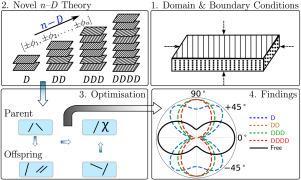超越双-双理论:复合材料层压板的n向堆叠顺序优化
IF 7.1
2区 材料科学
Q1 MATERIALS SCIENCE, COMPOSITES
引用次数: 0
摘要
本文提出了一种新的复合材料层压板的堆叠顺序设计框架,扩展了蔡崇信(Stephen Tsai)最近建立的双层(DD)层压板理论。通过引入和评价n-Double (n-D)布局,从单角度(D)序列到多向(DD、DDD、DDDD)设计;这项研究扩大了层压复合材料结构的设计空间,改善了抗屈曲和破坏强度之间的权衡。采用遗传算法(GA)优化了48层和64层石墨/环氧层压板在双轴和单轴压缩载荷下的堆叠顺序。结果表明,虽然基于ga的自由角度设计产生了最高的屈曲载荷,但结构化DDDD配置实现了相似或更好的破坏性能,并在几何变化中保持了高水平的鲁棒性。DDDD设计也接近ga级屈曲性能,具有显著改善的规律性和可制造性。这些发现强调了将Tsai的DD理论推广到n-D布局的好处,为层压优化提供了一种系统、实用和高性能的方法。本文章由计算机程序翻译,如有差异,请以英文原文为准。

Beyond Double-Double theory: n-Directional stacking sequence optimisation in composite laminates
This paper presents a novel stacking sequence design framework for composite laminates, extending the recently established Double-Double (DD) laminate theory developed by Stephen Tsai. By introducing and evaluating n-Double (n-D) layouts, ranging from single-angle (D) sequences to multi-directional designs such as DD, DDD, and DDDD; this study expands the design space for laminated composite structures, enabling improved trade-offs between buckling resistance and failure strength. A genetic algorithm (GA) is used to optimise the stacking sequences of 48- and 64-layer graphite/epoxy laminates under biaxial and uniaxial compressive loading across a range of geometric aspect ratios. Results show that while GA-based free-angle designs yield the highest buckling loads, structured DDDD configurations achieve similar or superior failure performance and maintain a high level of robustness across geometric variations. The DDDD designs also approximate GA-level buckling performance, with significantly improved regularity and manufacturability. These findings highlight the benefit of generalising Tsai’s DD theory towards n-D layouts, providing a systematic, practical, and high-performing approach to laminate optimisation.
求助全文
通过发布文献求助,成功后即可免费获取论文全文。
去求助
来源期刊

Composite Structures
工程技术-材料科学:复合
CiteScore
12.00
自引率
12.70%
发文量
1246
审稿时长
78 days
期刊介绍:
The past few decades have seen outstanding advances in the use of composite materials in structural applications. There can be little doubt that, within engineering circles, composites have revolutionised traditional design concepts and made possible an unparalleled range of new and exciting possibilities as viable materials for construction. Composite Structures, an International Journal, disseminates knowledge between users, manufacturers, designers and researchers involved in structures or structural components manufactured using composite materials.
The journal publishes papers which contribute to knowledge in the use of composite materials in engineering structures. Papers deal with design, research and development studies, experimental investigations, theoretical analysis and fabrication techniques relevant to the application of composites in load-bearing components for assemblies, ranging from individual components such as plates and shells to complete composite structures.
 求助内容:
求助内容: 应助结果提醒方式:
应助结果提醒方式:


